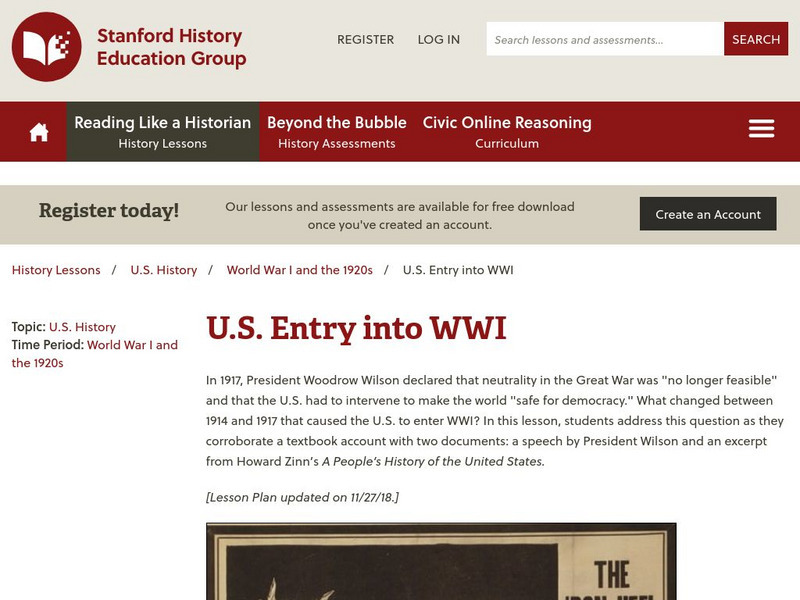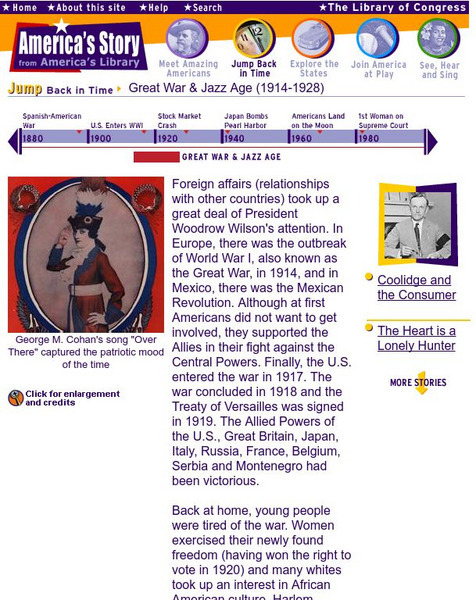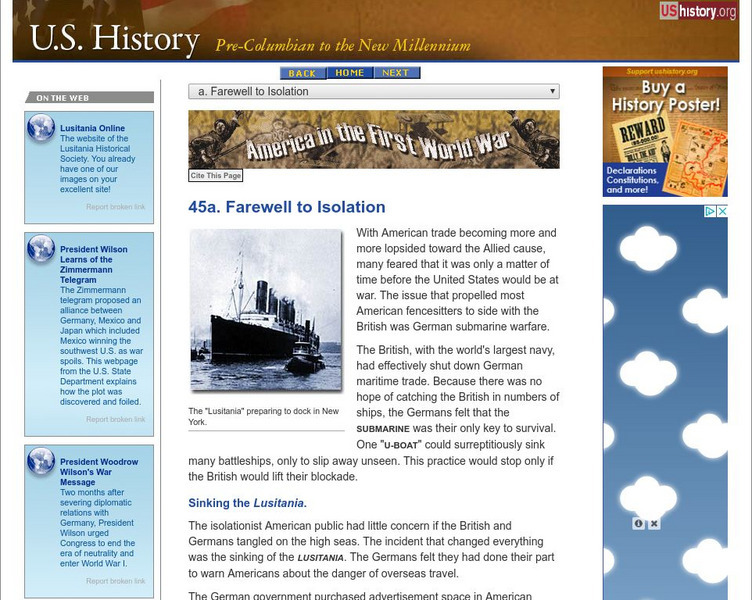OpenStax
Open Stax: Progressive Movement: New Voices for Women and African Americans
Examines how the women's rights movement began and how it evolved over time, followed by a look at the development of the African American civil rights movement and the different leaders that emerged during the Progressive Era.
PBS
Pbs Learning Media: Primary Source Set: World War I: America Heads to War
This collection uses primary sources to explore America's entry into World War I.
US Department of State
Biographies of the Secretaries of State: William Jennings Bryan (1860 1925)
William Jennings Bryan brief bio outlining his life as a lawyer and U.S. Statesman, nomitated to Secretary of State by President Woodrow Wilson.
Library of Congress
Loc: America's Story: The First Mother's Day
Mother's Day was begun by President Woodrow Wilson. This Library of Congress site gives you the background and some wonderful old photographs.
Khan Academy
Khan Academy: Us History: 1890 1945: The League of Nations
After World War I, US President Woodrow Wilson helped to build an international peacekeeping organization.
US Department of Justice
Office of the Attorney General: Thomas Watt Gregory
Find a brief biography and official portrait of Thomas Watt Gregory, Attorney General in Woodrow Wilson's cabinet from 1914 to 1919.
University of Texas at Austin
University of Texas: In Memoriam: David Franklin Houston
Read this University of Texas memorial to David Houston, who served as Woodrow Wilson's Secretary of Agriculture and Secretary of the Treasury.
Stanford University
Sheg: Document Based History: Reading Like a Historian: u.s. Entry Into Wwi
[Free Registration/Login Required] In this historical inquiry lesson, students address the question, "What changed between 1914 and 1917 that caused the U.S. to enter WWI?" to corroborate a textbook account with two documents: a speech...
PBS
Wnet: Thirteen: Freedom: A History of Us: The Peacemaker
Explore how President Wilson, in his Fourteen Points, urged peace without revenge European self-determination, and the establishment of a peace-keeping League of Nations politicians both abroad and at home rejected his plans.
US Army Center
U.s. Army Center of Military History: Peace Becomes Cold War, 1945 1950
A discussion of historical events that led to the Cold War from the perspective of the U.S. Army. Particular emphasis is placed on military leadership and policy.
PBS
Pbs: American Experience: Poster Art of World War I
In this American Experience site about Woodrow Wilson and his tenure as president, find a gallery of posters published to encourage the public's support for entry into World War I. The posters were produced as part of the Committee on...
Raleigh Charter High School
Mrs. Newmark's Page: World War One
This quiz will test your knowledge on WWI primarily information about President Wilson's actions during the war.
Independence Hall Association
U.s. History: The Treaty of Versailles and the League of Nations
President Wilson lobbied for a "just peace" for the end of World War I. Read about his Fourteen Points that he thought would accomplish this. See how his plans for a League of Nations and the final terms of the Treaty of Versailles...
Ohio History Central
Ohio History Central: Newton D. Baker
An interesting biography of Newton D. Baker, President Wilson's Secretary of War.
Library of Congress
Loc: America's Story: Great War & Jazz Age (1914 1928)
This Library of Congress time-line series surveys World War I and the Jazz Age. When World War I broke out in Europe, many changes were going on in the United States. Women were voting for the first time and African-American culture was...
Digital History
Digital History: Neutrality and the Lusitania [Pdf]
American neutrality in World War I was sorely tested with the attack and sinking of the passenger ship, Luisitania. Read information about the attack and find conflicting reactions by Franklin Roosevelt and William Jennings Bryan about...
Digital History
Digital History: The Rise of the Dictators [Pdf]
Use this lesson plan to explore the economic and political conditions in Europe after World War I as a result of the Treaty of Versailles that led to the rise of dictators in several countries. Read about the rise of Lenin and Stalin in...
Other
Wwi Resource Centre:the Politics of Pecuniary Aggrandizement: 1912 1920
A chapter from a 1937 book by Ferdinand Ludnberg, America's 60 Families, discusses how World War I was financed and who profited from the war. About halfway through the page is mention of the War Industries Board and the heads of...
Digital History
Digital History: The United States Wwi
This site explains how Germany resuming unrestricted submarine warfare contributed to the US entering WWI. Site is well-written, informative, and contains great details.
Oregon Secretary of State
Oregon at War: Before the War America's Strained Neutrality
Read about the attempts of the United States to remain neutral during World War I raging in Europe. Find out what finally made U.S. entrance into the war inevitable.
Digital Public Library of America
Dpla: World War I: America Heads to War
The sources in this primary set document explore the United States' brief but eventful involvement in World War I. Includes teaching guide.
US Department of the Treasury
Secretaries of the Treasury: Carter Glass
The accomplishments before, during, and after Carter Glass's tenure as Secretary of the Treasury are chronicled in this biography. A portrait of Glass is also provided.
Annenberg Foundation
Annenberg Learner: You Decide: Wilderness Preservation
The Hetch Hetchy controversy caused Presidents Roosevelt and Wilson to examine their beliefs, and then act upon them in ways that would forever change the American landscape. Should they have been more active in preserving wilderness...
Independence Hall Association
U.s. History: Farewell to Isolation
President Wilson's claim, "he kept us out of war," did not last. Read about the increasing number of reasons for American to declare war against Germany. See why war was finally declared in April, 1917.



















